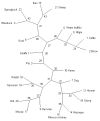Molecular evolution of bovine Toll-like receptor 2 suggests substitutions of functional relevance
- PMID: 18937834
- PMCID: PMC2588590
- DOI: 10.1186/1471-2148-8-288
Molecular evolution of bovine Toll-like receptor 2 suggests substitutions of functional relevance
Abstract
Background: There is accumulating evidence that polymorphism in Toll-like receptor (TLR) genes might be associated with disease resistance or susceptibility traits in livestock. Polymorphic sites affecting TLR function should exhibit signatures of positive selection, identified as a high ratio of non-synonymous to synonymous nucleotide substitutions (omega). Phylogeny based models of codon substitution based on estimates of omega for each amino acid position can therefore offer a valuable tool to predict sites of functional relevance. We have used this approach to identify such polymorphic sites within the bovine TLR2 genes from ten Bos indicus and Bos taurus cattle breeds. By analysing TLR2 gene phylogeny in a set of mammalian species and a subset of ruminant species we have estimated the selective pressure on individual sites and domains and identified polymorphisms at sites of putative functional importance.
Results: The omega were highest in the mammalian TLR2 domains thought to be responsible for ligand binding and lowest in regions responsible for heterodimerisation with other TLR-related molecules. Several positively-selected sites were detected in or around ligand-binding domains. However a comparison of the ruminant subset of TLR2 sequences with the whole mammalian set of sequences revealed that there has been less selective pressure among ruminants than in mammals as a whole. This suggests that there have been functional changes during ruminant evolution. Twenty newly-discovered non-synonymous polymorphic sites were identified in cattle. Three of them were localised at positions shaped by positive selection in the ruminant dataset (Leu227Phe, His305Pro, His326Gln) and in domains involved in the recognition of ligands. His326Gln is of particular interest as it consists of an exchange of differentially-charged amino acids at a position which has previously been shown to be crucial for ligand binding in human TLR2.
Conclusion: Within bovine TLR2, polymorphisms at amino acid positions 227, 305 and 326 map to functionally important sites of TLR2 and should be considered as candidate SNPs for immune related traits in cattle. A final proof of their functional relevance requires further studies to determine their functional effect on the immune response after stimulation with relevant ligands and/or their association with immune related traits in animals.
Figures


References
-
- Ozinsky A, Underhill DM, Fontenot JD, Hajjar AM, Smith KD, Wilson CB, Schroeder L, Aderem A. The repertoire for pattern recognition of pathogens by the innate immune system is defined by cooperation between toll-like receptors. Proc Natl Acad Sci USA. 2000;97(25):13766–13771. doi: 10.1073/pnas.250476497. - DOI - PMC - PubMed
-
- Hajjar AM, O'Mahony DS, Ozinsky A, Underhill DM, Aderem A, Klebanoff SJ, Wilson CB. Cutting edge: functional interactions between toll-like receptor (TLR) 2 and TLR1 or TLR6 in response to phenol-soluble modulin. J Immunol. 2001;166(1):15–19. - PubMed
Publication types
MeSH terms
Substances
Grants and funding
LinkOut - more resources
Full Text Sources

